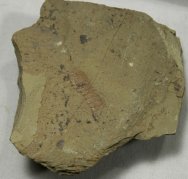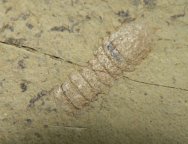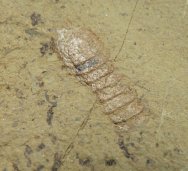Urokodia
aequlais
Phylum Arthropoda
Geological
Time: Early Cambrian (~525 million years ago)
Size (25.4mm=1
inch): Fossil is 15 mm long by 5 mm wide on a 55 mm by 55 mm matrix
Fossil
Site: Chengjiang Biota, Quiongzhusi Section, Yu’anshan Member,
Heilinpu Formation, Mafang Village, Haikou County, Kunming, Yunnan Province,
China
Fossil Code:
CJF1056
Price: Sold
| 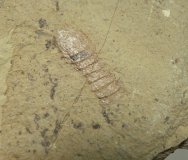 Description:
This unusual arthropod is known as Urokodia aequalis. The species
was described from only a few (~15) examples. With the discovery
of the Chengjiang Biota in 1984 a window on the Cambrian Explosion
in China was opened. The diversity of soft-tissue fossils is astonishing:
algae, medusiforms, sponges, priapulids, annelid like worms, echinoderms,
arthropods (including trilobites), hemichordates, chordates, and
the first Description:
This unusual arthropod is known as Urokodia aequalis. The species
was described from only a few (~15) examples. With the discovery
of the Chengjiang Biota in 1984 a window on the Cambrian Explosion
in China was opened. The diversity of soft-tissue fossils is astonishing:
algae, medusiforms, sponges, priapulids, annelid like worms, echinoderms,
arthropods (including trilobites), hemichordates, chordates, and
the first 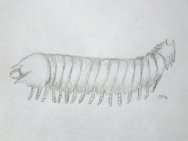 agnathan
fish make up just a small fraction of the total. Numerous problematic
forms are known as well, some of which may have represented failed
attempts at diversity that did not persist to the present day. agnathan
fish make up just a small fraction of the total. Numerous problematic
forms are known as well, some of which may have represented failed
attempts at diversity that did not persist to the present day.
The
taxon bears some resemblance to the younger Burgess Shale genus
Mollisonia, which has been found in the younger Kaili Biota of China
as well. The species derives its name from the equivalent size and
approximate appearance of both the posterior and anterior shields.
It is thought to have been a bottom-dwelling animal, most likely
a scavenger, but little is actually known since the only soft tissue
preservation found to date is a stout antenna.
|
|


